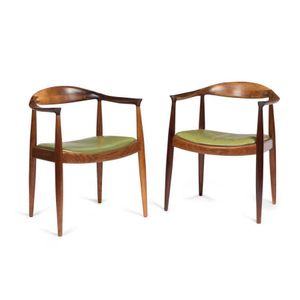Regency Mahogany Dining Chairs from Kraitzer Collection
A set of 4 late Regency spade back mahogany dining chairs, circa 1820, omprising 2 carver chairs and 2 standards. provenance: The Ian and Victoria Kraitzer Collection South Australia, previously the property of John Langdon Bonython of South Australia
You must be a subscriber, and be logged in to view price and dealer details.
Subscribe Now to view actual auction price for this item
When you subscribe, you have the option of setting the currency in which to display prices to $Au, $US, $NZ or Stg.
This item has been sold, and the description, image and price are for reference purposes only.
- Circa - A Latin term meaning 'about', often used in the antique trade to give an approximate date for the piece, usually considered to be five years on either side of the circa year. Thus, circa 1900 means the piece was made about 1900, probably between 1895 and 1905. The expression is sometimes abbreviated to c.1900.
- Provenance - A term used to describe the provable history of an antique or work of art, and thus an additional aid to verifying its authenticity. Provenance can have an inflating effect on the price of an item, particularly if the provenance relates to the early settlement of Australia, a famous person, or royalty. Less significant are previous sales of the item through an auction house or dealer.
- Regency Period - The Regency period in English furniture design refers to the period when King George III, was declared unfit to rule in 1811, and his son ruled as proxy as Prince Regent, until 1820, and then, after the death of his father as George IV until his death in 1830. The Regency period was preceded by the Georgian period (George I, George II, and George III: 1714 - 1811), and was followed by the William IV period, which only lasted until 1837 when William IV died as was succeeded by Queen Victoria.
- Mahogany - Mahogany is a dense, close grained red-coloured timber from the West Indies and Central America. It was first imported into Europe in the the early 18th century and its use continued through the 19th century. It was popular for furniture making because of its strength, the wide boards available, the distinctive grain on some boards, termed flame mahogany and the rich warm colour of the timber when it was polished.. The "flame" was produced where a limb grew out from the trunk of the tree, and this timber was usually sliced into veneers for feature panels on doors, backs and cornices.
Some terms used to describe mahogany relate to the country from which it originally came, such as "Cuban" mahogany, "Honduras" mahogany etc. However unless the wood has been tested the names assigned are more a selling feature, rather than a true indication of the timber's origin.
This item has been included into following indexes:
-
chairs, sets of 4, style or period
- all styles 491
- bar back / Trafalgar back / spade back 53
- Georgian 53
- Regency 35
- chairs, sets of 4, timber - mahogany 102
Visually similar items

A set of 10 mahogany spade back dining chairs, circa 1840
Sold by
in
for
You can display prices in $Au, $US, $NZ or Stg.

A set of eight William IV mahogany dining chairs, English, circa 1835, comprising a pair of scroll arm carvers and six dining chairs
Sold by
in
for
You can display prices in $Au, $US, $NZ or Stg.

A set of six tablet back mahogany dining chairs, including one carver, English, mid 19th century
Sold by
in
for
You can display prices in $Au, $US, $NZ or Stg.

A pair of mid 20th century birchwood carver dining chairs, Denmark 1950
Sold by
in
for
You can display prices in $Au, $US, $NZ or Stg.
